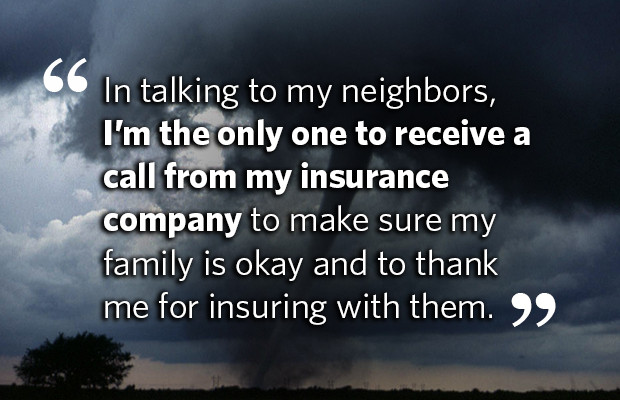It Takes a Long-term Strategy to Enable a Quick Response

How a tough business decision helped homeowners affected by the Cape Coral tornado
Wind Speeds up to 135mph.
Damage to 178 structures.
Those were a few of the reports following the EF-2 tornado that hit Cape Coral, FL, the evening of Saturday, January 9. The next morning, news crews posted photos of downed power lines, toppled cars and boats, uprooted palm trees and damage to homes.
Thankfully no serious injuries occurred, but homeowners were still left to deal with the aftermath of severe property damage and the permanent loss of irreplaceable family mementos. Unfortunately, the damage didn’t end with the dying winds. Sunday morning brought heavy rains that had homeowners scrambling to cover holes in roofs and broken windows.
Once the initial danger has passed and homeowners have assessed the damage to their property, they place urgent calls to loved ones and to their insurance companies.
Pro-active communication better serves customers
Fortunately for Security First Insurance customers, their homeowners insurance company was already at work and placing calls to them the following day.
As soon as Security First Insurance becomes aware of a storm warning or alert, the claims workflow springs into action. This includes prepping our call center employees, assessing the potential impact on businesses in the path of a storm, and communicating with our policyholders.
After the Cape Coral tornado, we called more than 100 customers in the immediate area to personally express our concern.
We also provided information on how to file a claim and reminded them of the online tools available, including the customer portal, My Security First, and free mobile app, Security First Mobile.
Feedback was positive, and we were thrilled to hear reactions like this from our customers:
“All four of my neighbors had extensive damage to their homes. Not one shingle was touched on my house. …But, in talking to my neighbors, I’m the only one to receive a call from my insurance company to make sure my family is okay and to thank me for insuring with them.”
We also wanted to warn our customers to not sign any documentation, such as an Assignment of Benefits (AOB) agreement. After experiencing storm damage, homeowners are understandably shaken and want their homes repaired as soon as possible. This is also the opportune time for unscrupulous contractors to take advantage storm victims. Insurance fraud is on the rise, and signing an AOB could cause homeowners to surrender control of the claim process and lose their right to their claim settlement.
The long-term strategy that enabled a quick response
A few days later, we followed up with an email to every single one of our policyholders in the affected area, reiterating what we communicated by phone and providing direct links to claim services. A second email communication went to the independent agents serving our policyholders to let them know we had called customers affected by the storm.
Being able to respond quickly and effectively after an emergency like this depends on a long-term strategy.
Our strategy increasingly employs technology to best serve our customers. That includes everything from our mobile app to email and data management. In fact, email became an integral aspect of our communication funnel following a tough business decision we made a few years ago. The decision? Require a valid email address from every customer before issuing a policy.
This decision seemed counter-intuitive to some, especially given the fact that our customer demographic includes a population that doesn’t engage regularly, if at all, in online communication. We announced the decision in December 2012 and implemented the requirement in early 2013. Since then, our email participation has increased from 11 percent to 85 percent participation.
After the tornado in Cape Coral, email not only enabled us to provide a summary of the claims process to our customers, it allowed us to help them better prepare for the future.
While it’s not pleasant to imagine having to go through such a terrible weather event again, we at Security First Insurance know first-hand how implementing a long-term strategy can help everyone–both Florida’s fourth largest insurance company and its homeowners–prepare to respond timely and meaningfully.
Posted in: Home, Insurance, Strategy, Technology
Leave a Comment (0) ↓